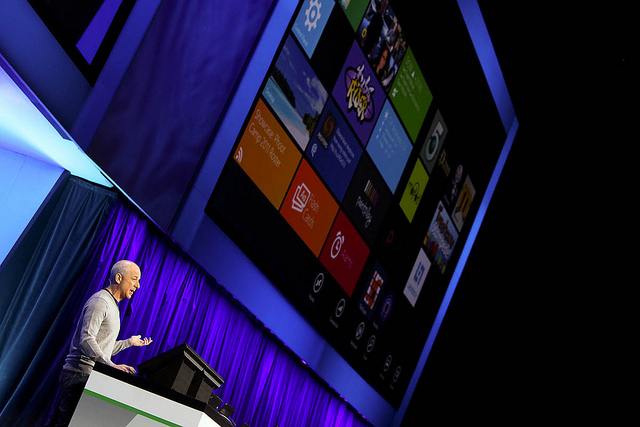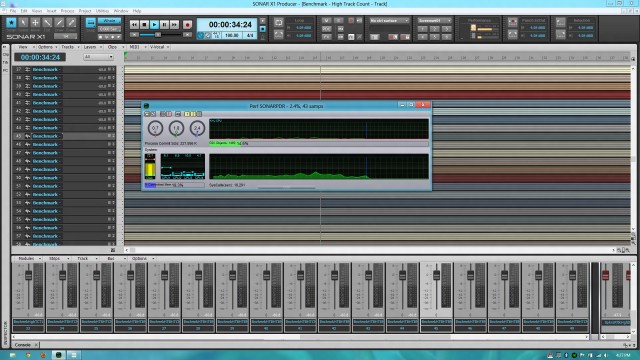
There’s good news and bad news on Windows 8 for music making. If you’re using Windows on a conventional, Intel PC, running conventional, desktop Windows apps, the news is really all good – really good. It’s still early days, but Windows 8 promises to be better than Windows 7 at audio performance metrics across the board, a no-brainer sort of upgrade for music makers.
By contrast, if you’re using Windows 8 on a new ARM-based tablet or interested in seeing music apps that take advantage of the new-fangled store and app coding style, the news is looking really pretty bad.
I’ve talked with various developers; Cakewalk CTO Noel Borthwick has been uniquely involved in researching what’s changed. He now releases details of how the developer tools work in Windows 8, as well as how desktop acts can be expected to perform, using an unmodified version of their SONAR DAW you may have running on your PC right now:
WINDOWS 8 – A BENCHMARK FOR MUSIC PRODUCTION APPLICATIONS [Cakewalk Blog]
For background, in 2009, Noel looked with us under the hood of Windows 7 – and everything there is relevant to desktop Windows apps today under Windows 8, with further improvements added in the new version of the OS. (See below.)
That is a must-read for the technically minded, but in case you’re not a developer or haven’t kept up with everything happening with Windows 8, I’m going to explain some of the background. I’ll look at the fundamentals of the new OS – or OSes, really – and then explain why one particular point on the version of Windows 8 you’d likely run on many tablets has a big deal-breaker for audio. (Opinion: These are my opinions, and my take on the engineering analysis as I understand it, not Noel’s or Cakewalk’s; it’s worth getting those ideas out there now in advance of the OS release as we expect to learn more as the thing ships.)
What It’s All About
Let’s explain, in terms as simple as possible. The easiest way to think about this is Standard Windows and New Windows. (I’ll say “standard” rather than “old,” because the “old” in this case seems to have gotten a lot of love and attention, and clearly isn’t going away.)
“Standard Windows” is Windows as you now know it, with years of experience in audio APIs that make Windows computers powerful for music applications. It’s the Windows that lets your hardware work, lets you plug in keyboards and audio interfaces, lets you run all the audio software you use, and get low-latency performance for virtual instruments and recording and anything else that makes sound. It’s not always friendly – installing special drivers and whatnot – but it does work. And it works not only for “pros,” but also “amateurs” who want to make music and don’t appreciate unexpected delays between when they do something and when they hear a sound. It works on computers that are general-purpose machines used by “punters” as the Brits like to say, people having nothing to do with music. Standard “Windows 8” is, simply, Windows running on Intel as you know it.
“New Windows” is based on some, but not all, of those ingredients, and introduces software that looks and works a bit differently than the Windows you know. It’s Metro running on Windows 8, the new design language involving all those colored square tiles you see, and now a set of graphic APIs for writing to it. It’s not the “old” design language you’ve seen in, say, Excel – or SONAR or Cubase – running on Windows 7, the business with the red X button and the transparent window bars. Then, there’s WinRT (short for Windows Runtime), a set of developer tools that let you code applications for “New Windows,” and distribute those apps in a new, Apple-style app store from Microsoft.
If you’re running a PC and you install Windows 8, you get both “Standard” and “New” Windows on your machine, and you can run each of the apps. So, when you do want to use Ableton Live or Cubase or SONAR or FL Studio, the Windows you know is there. If you want to look at a bunch of colored tiles or play some Angry Birds or use a Twitter app made for Metro, you can run that, too. You’ll find yourself buying those apps from a store, the way you do on an iPhone. The same is also true of the upcoming Surface Pro tablet: it’ll do both, which is why I think it will be uniquely interesting to musicians. (For some, it may be more interesting than even the iPad, because it won’t make you give up the apps you already use on your laptop or desktop machine.)
There is now, however, a breed of “Windows” computers that gives you no choice. Microsoft’s own non-Pro Surface is one example. These machines have ARM chips instead of Intel. And with just one set of exceptions – Microsoft’s office apps – they won’t run “Standard Windows.” They’ll only run the new-fangled Metro and WinRT stuff, via an operating system confusingly called Windows RT. Window RT is kind of Microsoft’s answer to iOS.
Ah, you say, but this is a good thing. If I’m using a slim, touch-only tablet, I don’t want a bunch of “legacy” apps that aren’t built for the new UI metaphors.
You’d be exactly right. And that’s why the bad news is really bad news if you were eyeing those machines. (Well, unless you like latency, in which case, I have, um, terrific news! You’re REALLY going to love the long moments of peace and quiet between when you strike a note and when you hear a sound! It’s not latency – it’s moments of contemplation!)
The Bad News About WinRT
Some of WinRT’s design is familiar to users of Android and iOS. You can’t really install plug-ins. (You can use native code, so, in fact, there’s nothing stopping things like libpd from working on Metro – complete with support for externals.) Okay, so, no deal-breaker there.
There’s also no support, at least that we can tell, for audio or MIDI hardware. That’s kind of a deal breaker, given you can take a range of audio and MIDI hardware and plug it directly into an iPad. But, part of the advantage of a tablet is portability, and this is a first-generation product, so let’s give them a pass there.
There’s WASAPI, the low-latency audio framework first seen in Windows Vista. Okay, that’s good news – low-latency audio framework. That’s what’s missing on Android, and what’s present (as “Core Audio”) on iOS, the guts that have made all these music apps possible on iPhone, iPad, and iPod touch.
Now, here’s the deal-killer: it’s missing the low-latency bits. Noel explains:
WASAPI supports low latency via what is known as “exclusive mode” where an application can bypass the high latency introduced by the system mixer. However based on reports from Microsoft it would appear that low latency audio applications were not considered in the Metro application model. See this blog post where Microsoft states that 100 msec was considered to be their goal for acceptable latency!
Updated: Just to clarify, since some folks are questioning whether this is as bad as it sounds, the issue is, without Exclusive Mode you do need to route audio through a device mixer that allows simultaneous audio from multiple apps. That’s a source of this latency and why you see the 100 ms figure. We’re still researching to find out if there really is no Exclusive Mode available in WinRT, but presently, it at the very least isn’t documented and isn’t working in apps.
Oh, yeah, and with no low-level support for driver models to replace that, you can’t plug in your own hardware to get high-quality, low-latency audio that way. You’re just, uh, out of luck. (Someone suggested that Steinberg would release ASIO for WinRT. That might be the case, if it were possible. Based on current documentation, it’s not. It would also need to be in the form of a device-specific library, released with each app, based on other development requirements, so you really do need this in the OS.)
Unless we receive new information, that means it’s safe to describe Windows 8’s WinRT as completely tone-deaf. It means Microsoft learned none of the lessons of what Apple accomplished, and what Google failed to accomplish, that really nailing the quality of your multimedia layer in software.
If this developer information is correct and complete, it would Apple raised the bar, and then Microsoft lowered it again. And it’s especially unforgivable, because unlike Google, Microsoft actually does have experience at this. Which brings us to the good news – for desktop users, that is.
Windows 8 is Looking Better Than Windows 7

Desktop users, if this was making you feel bleak, don’t. It’s just a first benchmark, so should be taken with a grain of salt, but in testing SONAR on Windows 8, Noel finds a litany of performance improvements across the board, in areas like:
- Hard disk throughput
- Lower CPU load in low-latency situations
- Reduced memory usage
- Overall reduced CPU load and fewer audio glitches, thanks to improvements in the kernel and “system calls”
In short:
The results of the benchmarks were surprisingly good! Windows 8 performed better than Windows 7 across the board in all categories, and in many cases with fairly dramatic performance gains.
Why This Matters
The logical conclusions here:
1. Windows 8 will probably be a great upgrade for musicians on the desktop Windows platform.
2. For people wanting to run the new software environment, or use new ARM-based tablets, we’d need some evidence to demonstrate that this is a usable OS for music. Based on current information, it’s not – not for many applications.
You should read Noel’s analysis, but he reaches similar conclusions.
Here’s the rub: the fact that Windows 8 is so good when running conventional apps almost makes it more frustrating that so many new tablets will be left out of the party. Now, you could argue that “average” users don’t need such things, and I’m just a “niche” musician droning on about something that matters to me – and you’d be partly right. But average users share some of the same powers of perception with sound that advanced users do; there’s actual research on that. Average users can hear, and respond negatively to, 100 ms latency. And average users have made the iPad and iPhone some of the most successful products in history. Whether this was a deciding factor, it didn’t stop the mass market from buying them.
You could also argue that low latency concerns would make too great a sacrifice in battery life or app security. There, not only is the iPad evidence to the contrary, but so, too, is Windows itself. Not all apps need these features, but then why not build them into the OS for those that do?
If Microsoft really did fail to learn from their own engineering accomplishments on Windows, then it’s the obligation of those of us who do know something about sound to be, well, noisy about it.
When stuff works, it usually doesn’t work by accident – that’s true of all the OSes available today.
I’d love to be proven wrong, before Windows 8 ships on these devices. We’ll be watching, and will have more complete advice for musicians on all these platforms as these tools become available.